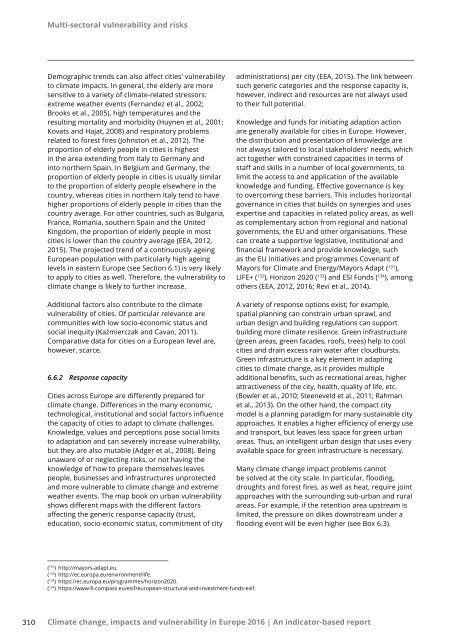Climate change impacts and vulnerability in Europe 2016
document
document
You also want an ePaper? Increase the reach of your titles
YUMPU automatically turns print PDFs into web optimized ePapers that Google loves.
Multi-sectoral <strong>vulnerability</strong> <strong>and</strong> risks<br />
Demographic trends can also affect cities' <strong>vulnerability</strong><br />
to climate <strong>impacts</strong>. In general, the elderly are more<br />
sensitive to a variety of climate-related stressors:<br />
extreme weather events (Fern<strong>and</strong>ez et al., 2002;<br />
Brooks et al., 2005), high temperatures <strong>and</strong> the<br />
result<strong>in</strong>g mortality <strong>and</strong> morbidity (Huynen et al., 2001;<br />
Kovats <strong>and</strong> Hajat, 2008) <strong>and</strong> respiratory problems<br />
related to forest fires (Johnston et al., 2012). The<br />
proportion of elderly people <strong>in</strong> cities is highest<br />
<strong>in</strong> the area extend<strong>in</strong>g from Italy to Germany <strong>and</strong><br />
<strong>in</strong>to northern Spa<strong>in</strong>. In Belgium <strong>and</strong> Germany, the<br />
proportion of elderly people <strong>in</strong> cities is usually similar<br />
to the proportion of elderly people elsewhere <strong>in</strong> the<br />
country, whereas cities <strong>in</strong> northern Italy tend to have<br />
higher proportions of elderly people <strong>in</strong> cities than the<br />
country average. For other countries, such as Bulgaria,<br />
France, Romania, southern Spa<strong>in</strong> <strong>and</strong> the United<br />
K<strong>in</strong>gdom, the proportion of elderly people <strong>in</strong> most<br />
cities is lower than the country average (EEA, 2012,<br />
2015). The projected trend of a cont<strong>in</strong>uously age<strong>in</strong>g<br />
<strong>Europe</strong>an population with particularly high age<strong>in</strong>g<br />
levels <strong>in</strong> eastern <strong>Europe</strong> (see Section 6.1) is very likely<br />
to apply to cities as well. Therefore, the <strong>vulnerability</strong> to<br />
climate <strong>change</strong> is likely to further <strong>in</strong>crease.<br />
Additional factors also contribute to the climate<br />
<strong>vulnerability</strong> of cities. Of particular relevance are<br />
communities with low socio-economic status <strong>and</strong><br />
social <strong>in</strong>equity (Kaźmierczak <strong>and</strong> Cavan, 2011).<br />
Comparative data for cities on a <strong>Europe</strong>an level are,<br />
however, scarce.<br />
6.6.2 Response capacity<br />
Cities across <strong>Europe</strong> are differently prepared for<br />
climate <strong>change</strong>. Differences <strong>in</strong> the many economic,<br />
technological, <strong>in</strong>stitutional <strong>and</strong> social factors <strong>in</strong>fluence<br />
the capacity of cities to adapt to climate challenges.<br />
Knowledge, values <strong>and</strong> perceptions pose social limits<br />
to adaptation <strong>and</strong> can severely <strong>in</strong>crease <strong>vulnerability</strong>,<br />
but they are also mutable (Adger et al., 2008). Be<strong>in</strong>g<br />
unaware of or neglect<strong>in</strong>g risks, or not hav<strong>in</strong>g the<br />
knowledge of how to prepare themselves leaves<br />
people, bus<strong>in</strong>esses <strong>and</strong> <strong>in</strong>frastructures unprotected<br />
<strong>and</strong> more vulnerable to climate <strong>change</strong> <strong>and</strong> extreme<br />
weather events. The map book on urban <strong>vulnerability</strong><br />
shows different maps with the different factors<br />
affect<strong>in</strong>g the generic response capacity (trust,<br />
education, socio-economic status, commitment of city<br />
adm<strong>in</strong>istrations) per city (EEA, 2015). The l<strong>in</strong>k between<br />
such generic categories <strong>and</strong> the response capacity is,<br />
however, <strong>in</strong>direct <strong>and</strong> resources are not always used<br />
to their full potential.<br />
Knowledge <strong>and</strong> funds for <strong>in</strong>itiat<strong>in</strong>g adaption action<br />
are generally available for cities <strong>in</strong> <strong>Europe</strong>. However,<br />
the distribution <strong>and</strong> presentation of knowledge are<br />
not always tailored to local stakeholders' needs, which<br />
act together with constra<strong>in</strong>ed capacities <strong>in</strong> terms of<br />
staff <strong>and</strong> skills <strong>in</strong> a number of local governments, to<br />
limit the access to <strong>and</strong> application of the available<br />
knowledge <strong>and</strong> fund<strong>in</strong>g. Effective governance is key<br />
to overcom<strong>in</strong>g these barriers. This <strong>in</strong>cludes horizontal<br />
governance <strong>in</strong> cities that builds on synergies <strong>and</strong> uses<br />
expertise <strong>and</strong> capacities <strong>in</strong> related policy areas, as well<br />
as complementary action from regional <strong>and</strong> national<br />
governments, the EU <strong>and</strong> other organisations. These<br />
can create a supportive legislative, <strong>in</strong>stitutional <strong>and</strong><br />
f<strong>in</strong>ancial framework <strong>and</strong> provide knowledge, such<br />
as the EU <strong>in</strong>itiatives <strong>and</strong> programmes Covenant of<br />
Mayors for <strong>Climate</strong> <strong>and</strong> Energy/Mayors Adapt ( 131 ),<br />
LIFE+ ( 132 ), Horizon 2020 ( 133 ) <strong>and</strong> ESI Funds ( 134 ), among<br />
others (EEA, 2012, <strong>2016</strong>; Revi et al., 2014).<br />
A variety of response options exist; for example,<br />
spatial plann<strong>in</strong>g can constra<strong>in</strong> urban sprawl, <strong>and</strong><br />
urban design <strong>and</strong> build<strong>in</strong>g regulations can support<br />
build<strong>in</strong>g more climate resilience. Green <strong>in</strong>frastructure<br />
(green areas, green facades, roofs, trees) help to cool<br />
cities <strong>and</strong> dra<strong>in</strong> excess ra<strong>in</strong> water after cloudbursts.<br />
Green <strong>in</strong>frastructure is a key element <strong>in</strong> adapt<strong>in</strong>g<br />
cities to climate <strong>change</strong>, as it provides multiple<br />
additional benefits, such as recreational areas, higher<br />
attractiveness of the city, health, quality of life, etc.<br />
(Bowler et al., 2010; Steeneveld et al., 2011; Rahman<br />
et al., 2013). On the other h<strong>and</strong>, the compact city<br />
model is a plann<strong>in</strong>g paradigm for many susta<strong>in</strong>able city<br />
approaches. It enables a higher efficiency of energy use<br />
<strong>and</strong> transport, but leaves less space for green urban<br />
areas. Thus, an <strong>in</strong>telligent urban design that uses every<br />
available space for green <strong>in</strong>frastructure is necessary.<br />
Many climate <strong>change</strong> impact problems cannot<br />
be solved at the city scale. In particular, flood<strong>in</strong>g,<br />
droughts <strong>and</strong> forest fires, as well as heat, require jo<strong>in</strong>t<br />
approaches with the surround<strong>in</strong>g sub-urban <strong>and</strong> rural<br />
areas. For example, if the retention area upstream is<br />
limited, the pressure on dikes downstream under a<br />
flood<strong>in</strong>g event will be even higher (see Box 6.3).<br />
( 131 ) http://mayors-adapt.eu.<br />
( 132 ) http://ec.europa.eu/environment/life.<br />
( 133 ) https://ec.europa.eu/programmes/horizon2020.<br />
( 134 ) https://www.fi-compass.eu/esif/european-structural-<strong>and</strong>-<strong>in</strong>vestment-funds-esif.<br />
310 <strong>Climate</strong> <strong>change</strong>, <strong>impacts</strong> <strong>and</strong> <strong>vulnerability</strong> <strong>in</strong> <strong>Europe</strong> <strong>2016</strong> | An <strong>in</strong>dicator-based report


